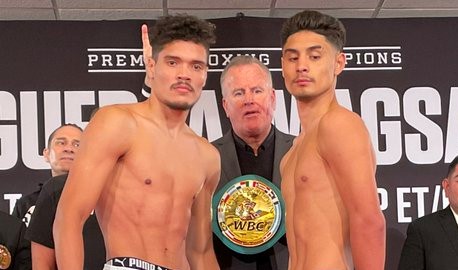By Tom Donelson
Judging a fight is very subjective. The one area in which most boxing pundits and judges appear to agree is the effect of a knockdown upon scoring. It i
s boxing tradition that if a fighter’s butt hit the canvas, he will lose a round by two points.
What if a fighter so dominates a round but fails to knock down his opponent down? Does he deserve a 10-8 round? Most judges will award a 10-9, regardless. For most judges, the knockdown is the defining standard. Knock your opponent down and you will get a 10-8.
When I asked Mike DeLisa of Cyberboxingzone.com, he said, “It all depends. I don’t need a knockdown for a 2-point round, nor do I automatically give a 10-8 for a knockdown. I ALWAYS give the round to a fighter who has scored a knockdown by at least 10-9 — sort of a bright line I can’t pass.” Michael DeLisa envisions a scenario in which a fighter wins a round by two points without a knockdown and at least a fighter can never lose a round if he knocks the opponent down.
Showtime Nick Charles adds, “My opinion of domination is when an opponent can neither fight back (in which the referee can and often should stop the fight) or a knockdown in which the domination is so complete it forces a halt however temporary. The difference to me is that when a boxer can’t fight back he’s rendered defenseless and the fight is over. That would be a 10-8 only in the round that the fight ended. -E.g. 7.” He added, “I strongly believe a boxer can rally from a knockdown and lose the round 10-9.”
Roland Munoz of Ringsports.com believes a knockdown is usually a 10-8 round. He would reward rounds without knockdown 10-9 with the rare exception that a fighter dominates a fighter to a point that ref would stop a fight but doesn’t it. But as Roland notes, “Scoring is probably irrelevant.”
The bottom line is that most judges and writers believe that a knock down round is a 10-8 but there is some division if a fighter could earn a 10-8 without a knock down.
Boxing historian and writer Frank Lotierzo writes, “When watching a fight, what are the scenarios that can occur during a round in which a knockout or stoppage doesn’t occur? Basically, there are three, 1.) A fighter can be awarded the round by the slightest of margins over his opponent in a round that there wasn’t much separating them, 2.) A fighter can totally dominate the opponent from start to finish, but not knock him down. 3.) A fighter can totally overwhelm his opponent in the round scoring one or more knockdowns. The only other scenario’s that are likely to take place is both fighters putting each other down in the round, or one fighter dominates the round and gets dropped at the end of the round. Regardless of the scoring system, the last two settings are left up to the discretion of the judges in as to how they score the round.”
Lotierzo believes that we need to eliminate the 10-point must system and beg
in anew with a new scoring. Lotierzo believes that we should have a 3-point system. Frank thinks a fighter should earn his points and if neither fighter accomplishes anything of consequences then neither should get any points.
A fighter should earn 1 point if the round is close but the fighter dominates down the stretch. A fighter should gain 2 points if he dominates the whole round and it is obvious. As Frank writes, “Under the 10-point must, this round would be scored 10-9. I say score it 2-0 since fighter B has won the round without question. Since there is no question about the round, shouldn’t the dominant fighter be rewarded?” If a fighter knocks his opponent down once or multiple times, give the fighter a 3-point advantage
Frank’s system is one way to add some objectivity to the scoring while rewarding the fighter for his efforts. How could this system affect past fight? A couple of years ago, there was major fight with two evenly match fighters. There were six rounds that were close but there were six rounds that saw one fighter dominate the other. Opponent A won five of those rounds with accurate punching and excellent foot movement. Under the Frank system, he would have been awarded 2-0 round for his effort. Opponent B won one round with brisk inside punching and effective power punching. He would have gained a 2-0 round in that round. As for the close rounds, Opponent B was given all of those rounds and would be awarded 1-0 for those six rounds under the Lotierzo’s system. In the real fight, Opponent B won the fight 115-113 (seven rounds to five). All of these rounds were awarded 10-9. Neither fighter got proper credit for the rounds they easily dominated. Under Frank system, Opponent A would have won the fight 10-8.
This fight was controversial with many observers including this writer thinking Opponent A won. The biggest problem with scoring is that all rounds are considered the same. If fighter A boxes and set the pace for the round while scoring effectively, he is given no more credit that if two fighters are both competitive during the round. This is where the scoring flaws come in. Not all rounds are equal.
The beauty of the Lotierzo system is that judges will be given leeway to sco
re the fight and reward fighters for dominating the round without a knock down. The other beauty is that judges will have a standard to judge a round in which a knockdown or knockdowns occur. It is a 3-point round.
The first flaw of the present system is a winner of a round must be declared even if there was no clear winner. The second flaw is all rounds are treated as the same and many fighters are short changed for their effort in the fight. Why should a fighter who wins a round by a wide margin be treated the same as a fighter who might win a round by landing just one more punch than his opponent? Lotierzo system begins to eliminate this flaw.

















